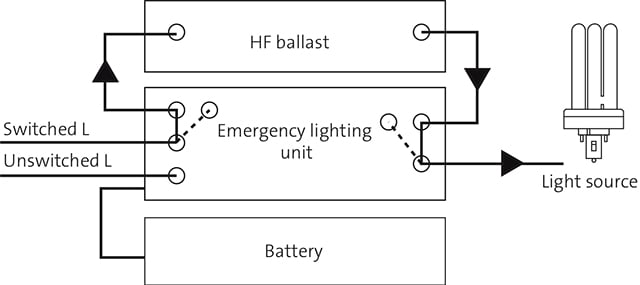
Operation and light source
The light source, often a fluorescent tube, is operated in emergency mode by the emergency lighting unit instead of the normal ballast. The emergency lighting unit is connected between the normal ballast and the light source, and in the event of power failure or test, the emergency lighting unit automatically switches over to emergency mode.
Emergency mode produces a reduced light source output, normally between 5–30 % of the normal output. This puts great demands on the emergency lighting unit’s method of operating the light source. Faulty operation can result in the fluorescent light tube wearing out when in use. When the mains supply is fully restored, the tube will not relight since the normal ballast will detect that the fluorescent tube is defective. This problem is eliminated by using a suitable emergency lighting unit.
Schematic construction of a decentralised emergency lighting luminaire.
Compact fluorescent lamp amalgams and T5 light sources
Compact fluorescent lamps using amalgam technology and T5 light sources are produced to give their greatest luminous flux at a higher ambient temperature than mercury type light sources. Compact light sources with amalgam are mainly used in downlights.
The construction of an amalgam light source requires specially adapted emergency lighting electronics. Until it has warmed up sufficiently, a cold amalgam light source needs increased output, referred to as a boost. After several minutes, the output can be reduced to normal levels. Similarly this requires that the temperature in the fluorescent tube cathodes is kept at an acceptable level. The emergency lighting electronics does this by regulating the current through the cathodes. To operate an amalgam light source without this means both dramatically shortened life-span and results in luminous flux not reaching acceptable and usable levels when in emergency mode.
The emergency lighting electronics for amalgam light sources are also suitable for operating mercury lamps.
The T5 light source has a design which, compared with T8 fluorescent lamps, requires better control of how the light source is operated and switched on. In order to minimise the wear on the light source, the emergency lighting electronics must be provided with a function that pre-heats the fluorescent lamp electrodes and which monitors that the light source is being operated within its specifications.
Battery type
With very few exceptions, emergency lighting luminaires use either NiCd or NiMH batteries. Due to their environmental impact, NiCd batteries should not be used unless absolutely necessary for the emergency lighting function. Additionally in a number of countries, an environmental tax is levied on NiCd.
If an emergency luminaire requires NiCd batteries for reasons of temperature, the lighting installation could be supplemented by an installation based on a combination of standard luminaires and a separate emLED emergency lighting system which uses NiMH batteries.
Such a system not only reduces the use of environmentally damaging substances, it also often means a better lighting installation, simpler and cheaper maintenance and increased personal safety.
Battery charging
To optimise the battery’s life-span, the charging must be done in a way that is suited to the battery type. With faulty charging, the battery can quickly lose its capacity to store energy.
Changing batteries
The normal life-span for a battery is at least four years. This is assuming however that the product is being used correctly and that the stated tests are carried out. Batteries should be changed quickly as the emergency mode time becomes too short. Our emergency lighting products are designed for battery changes to be as simple as possible.
Re-lamping in emergency mode, BLF
Re-lamping in emergency mode is known as BLF (Ballast Lumen Factor). Depending on the choice of light source, emergency lighting electronics and associated batteries, different combinations have a different BLF. BLF normally lies within the range 0.05–0.30, i.e. the light source shines in emergency mode with between 5–30 % of its nominal flux.
Luminaire construction – electronic life-span
From a construction perspective, emergency lighting electronics are very much like a standard HF ballast, such as being sensitive to high temperatures. When we develop emergency lighting luminaires, we apply the same policy as for products with other forms of electronics. We will have a margin to the reference temperature, tc, stated by the electronics manufacturer, which is equivalent to 50,000 hours life-span with a maximum of 10 % decline. The temperature and other electrical safety is inspected by our authorised lighting laboratory.
Luminaires for centralised systems
For centralised systems, luminaires must be used that are suited to the voltage and curve form that the central unit generates in emergency mode. This is normally 220–230 V AC or the equivalent DC voltage and the majority of luminaires with HF ballasts can be connected to such installations. An inspection must be made however before the luminaires are energised.
In central systems, light sources with integrated starters may not be used, e.g. 2-pin compact fluorescent lamps. For central systems, we only recommend luminaires equipped with either HF ballasts, LEDs, incandescent lamps or halogen light sources.
